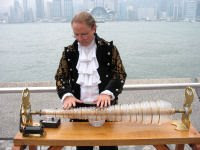Webster's New Collegiate Dictionary defines it as, "to attract and move deeply: rouse to ecstatic admiration." What an utterly apt description of my experience at the Alhambra. It was a revelation to me. Light, space, water and natural materials combine to create a style of architecture that speaks to me deeply.


 We arrived in Granada in the late afternoon and had some time to explore Albaicin because our first visit to the Alhambra was not until later that night at 10:00. Seeing the Alhambra from the hill of Albaicin whetted my appetite. It's one of the most stunning views that I've ever seen.
We arrived in Granada in the late afternoon and had some time to explore Albaicin because our first visit to the Alhambra was not until later that night at 10:00. Seeing the Alhambra from the hill of Albaicin whetted my appetite. It's one of the most stunning views that I've ever seen.
The Alhambra's Nasrid Palace is open for nighttime visitors five days a week. Night visits to the Nasrid Palace have become so popular that Laure had to reserve our tickets in advance. We still had to wait in line for a half hour to pick them up. With so many people in line my heart began to sink. In general, I do not enjoy crowds of people, particularly large groups of tourists all bunched together and all seemingly flashing their cameras at exactly the same time.
To my surprise and delight, Laure and I managed to find ourselves virtually alone on the long, beautifully illuminated path to the Nasrid Palace. Imagine, if you can, a long cobblestone path lined with large cypress trees, some of them pruned in the shape of arches that give you glimpses of pools and gardens. A soft, early nighttime breeze wafts over you bringing with it the scents of jasmine and orange blossom. This captivating fragrance is accompanied by the chirping of frogs. The city of Granada surrounds you on three sides but you are hardly aware of its presence until later in the evening when you see and hear a fireworks display.
That walk will stay in my memory forever. It was as magical and wonderful as anything that I could have imagined. I only wish that I had pictures to share with you, although I really don't think that they could even begin to capture the magic of that walk. Still, here's a picture taken of the Alhambra at sunset. It's not the same as that dusky walk but perhaps it evokes at least a bit of the magical feel of the place.


My poor photos cannot do this wonderful place justice, even with the beautiful, snow covered mountains of the Sierra Nevada in the background. This view is from the opposite hill in the Albaicin, where narrow streets, cobbled alleys and villas with beautiful gardens cling to the hillside. Here are a few more photos of the Alhambra from Albaicin.





 We arrived in Granada in the late afternoon and had some time to explore Albaicin because our first visit to the Alhambra was not until later that night at 10:00. Seeing the Alhambra from the hill of Albaicin whetted my appetite. It's one of the most stunning views that I've ever seen.
We arrived in Granada in the late afternoon and had some time to explore Albaicin because our first visit to the Alhambra was not until later that night at 10:00. Seeing the Alhambra from the hill of Albaicin whetted my appetite. It's one of the most stunning views that I've ever seen.The Alhambra's Nasrid Palace is open for nighttime visitors five days a week. Night visits to the Nasrid Palace have become so popular that Laure had to reserve our tickets in advance. We still had to wait in line for a half hour to pick them up. With so many people in line my heart began to sink. In general, I do not enjoy crowds of people, particularly large groups of tourists all bunched together and all seemingly flashing their cameras at exactly the same time.
To my surprise and delight, Laure and I managed to find ourselves virtually alone on the long, beautifully illuminated path to the Nasrid Palace. Imagine, if you can, a long cobblestone path lined with large cypress trees, some of them pruned in the shape of arches that give you glimpses of pools and gardens. A soft, early nighttime breeze wafts over you bringing with it the scents of jasmine and orange blossom. This captivating fragrance is accompanied by the chirping of frogs. The city of Granada surrounds you on three sides but you are hardly aware of its presence until later in the evening when you see and hear a fireworks display.
That walk will stay in my memory forever. It was as magical and wonderful as anything that I could have imagined. I only wish that I had pictures to share with you, although I really don't think that they could even begin to capture the magic of that walk. Still, here's a picture taken of the Alhambra at sunset. It's not the same as that dusky walk but perhaps it evokes at least a bit of the magical feel of the place.

I do have a few pictures taken inside the Nasrid Palace and although most of them are very blurry I share them with you to try and give you even a small sense of the amazing feel of the palace.
Oddly enough, even though the exposure is off I think this is a cool picture. 



On the Internet I found these two pictures by Ayahs Bahru, who visited the Nasrid Palace, about three weeks after we did. The photos are beautiful! Way to go Ayahs! These begin to capture some of the magic of the place, and the intricacy and detail of the work.




On the Internet I found these two pictures by Ayahs Bahru, who visited the Nasrid Palace, about three weeks after we did. The photos are beautiful! Way to go Ayahs! These begin to capture some of the magic of the place, and the intricacy and detail of the work.
What I so appreciate about this style of architecture is that the materials used are very modest. Plaster, timber and tiles are predominant. But what they do with those materials is astonishing. This particular type of arch is called a "honeycomb" arch.

This is the ceiling of the Sala de los Abencerrajes. This just hints at the exquisite and elaborate detail in the stucco work that makes up this domed ceiling.
You can catch a faint glimpse of the blue color. Imagine what the colors would have looked like around 1354 when most of the work in the palace was complete. It must have been stunning!

This is a side view of the Patio de Arrayanes. The Moors used a lot of reflective water in their architecture to create a greater feeling of space and light, which is reflected from the pool into the surrounding halls.
Hollywood had nothing on the Sultans of the Alhambra for knowing the importance of good lighting!

The craftsmanship in the Alhambra is really amazing and is found elsewhere throughout Andalusia where the Moors has the most influence.
Check out this workmanship! It's all in details....

Here's Patio de Arraynes with the reflecting pool and the fortress that containes the Salon de Embajadores (throne room) in the background.

Here's a picture that I took the next day that makes some of the details of the arch easier to see.

This is the ceiling of the Sala de los Abencerrajes. This just hints at the exquisite and elaborate detail in the stucco work that makes up this domed ceiling.
You can catch a faint glimpse of the blue color. Imagine what the colors would have looked like around 1354 when most of the work in the palace was complete. It must have been stunning!
Below are more pictures of the palace taken the next day.

This is a side view of the Patio de Arrayanes. The Moors used a lot of reflective water in their architecture to create a greater feeling of space and light, which is reflected from the pool into the surrounding halls.
Completed in 1365, The Patio del Mexuar was a council chamber where the sultan du jour held meetings with his ministers and listened to the petitions of his subjects.
The picture below shows the detail of the tile between the two entrances. The Sultan's throne would be placed there. The patio has a fountain in the center so the sound of water would have always been present. In addition, the light came from behind the patio so that the light would have been in the eyes of the Sultan's ministers and subjects. There's nothing like being in the power position, both literally and figuratively!
The picture below shows the detail of the tile between the two entrances. The Sultan's throne would be placed there. The patio has a fountain in the center so the sound of water would have always been present. In addition, the light came from behind the patio so that the light would have been in the eyes of the Sultan's ministers and subjects. There's nothing like being in the power position, both literally and figuratively!
Hollywood had nothing on the Sultans of the Alhambra for knowing the importance of good lighting!

The craftsmanship in the Alhambra is really amazing and is found elsewhere throughout Andalusia where the Moors has the most influence.
Check out this workmanship! It's all in details....
This beautiful work is found in and around the Patio de Arrayanes. Remember that they are using wood, plaster and tiles; all natural materials.


Here's Patio de Arraynes with the reflecting pool and the fortress that containes the Salon de Embajadores (throne room) in the background.

In another part of the palace lies the Patio de los Leones, built by Muhammad V and known for its central fountain featuring 12 lions, who were, unfortunately absent at the time due to an appointment with the resident restorer. It's a shame because it's a great space and that ugly big box protecting the fountain's base does not really add to the beauty of the filigreed arcades and the marble columns.
These pictures show the Patio with the lions still in residence. The small culverts you see lead to other smaller fountains hidden under the arches that surround the patio. This patio is one of the most photographed places in the Alhambra and with good reason. There are four buildings surrounding the patio that make up the heart of the Harem, where the sultan lived with his closest family members. 


More photos in the Nasrid Palace. These are of Lindaraxa's garden, one of the most photographed and painted parts of the Alhambra.

Here's what Washington Irving wrote about Lindaraxa and her garden in "Tales of the Alhambra."
"One window of the royal sleeping-room commanded a prospect of the Generalife and its embowered terraces; another looked out into the little secluded garden I have mentioned, which was decidedly Moorish in its character, and also had its history. It was in fact the garden of Lindaraxa, so often mentioned in descriptions of the Alhambra, but who this Lindaraxa was I had never heard explained. A little research gave me the few particulars known about her. She was a Moorish beauty who flourished in the court of Mohamed the Left-Handed, and was the daughter of his loyal adherent, the governor of Malaga, who sheltered him in his city when driven from the throne. On regaining his crown, the governor was rewarded for his fidelity. His daughter had her apartment in the Alhambra, and was given by the king in marriage to Nasar, a young prince descended from Aben Hud the Just.
Four centuries had elapsed since the fair Lindaraxa passed away, yet how much of the fragile beauty of the scenes she inhabited remained! The garden still bloomed [66] in which she delighted; the fountain still presented the crystal mirror in which her charms may once have been reflected; the alabaster, it is true, had lost its whiteness; the basin beneath, overrun with weeds, had become the lurking-place of the lizard, but there was something in the very decay that enhanced the interest of the scene, speaking as it did of that mutability, the irrevocable lot of man and all his works."


One of the spaces off this patio is the Sala de los Abencerrajes. There is a sad history to this hall. It is named after a noble family who lived there during the reign of last Sultan of Granada, Boabdil. The Abencerrajes were rivals of Boabdil and the legend goes that he had them all massacred while attending a banquet in this hall. There is a fountain in the center of the floor. Around the fountain you can see some dark stains and the legend also says that these stains are the blood of the Abencerrajes. The geometrical ceiling of the room is spectacular and inspired by Pythagoras' theorem.

More photos in the Nasrid Palace. These are of Lindaraxa's garden, one of the most photographed and painted parts of the Alhambra.

Here's what Washington Irving wrote about Lindaraxa and her garden in "Tales of the Alhambra."
"One window of the royal sleeping-room commanded a prospect of the Generalife and its embowered terraces; another looked out into the little secluded garden I have mentioned, which was decidedly Moorish in its character, and also had its history. It was in fact the garden of Lindaraxa, so often mentioned in descriptions of the Alhambra, but who this Lindaraxa was I had never heard explained. A little research gave me the few particulars known about her. She was a Moorish beauty who flourished in the court of Mohamed the Left-Handed, and was the daughter of his loyal adherent, the governor of Malaga, who sheltered him in his city when driven from the throne. On regaining his crown, the governor was rewarded for his fidelity. His daughter had her apartment in the Alhambra, and was given by the king in marriage to Nasar, a young prince descended from Aben Hud the Just.
Four centuries had elapsed since the fair Lindaraxa passed away, yet how much of the fragile beauty of the scenes she inhabited remained! The garden still bloomed [66] in which she delighted; the fountain still presented the crystal mirror in which her charms may once have been reflected; the alabaster, it is true, had lost its whiteness; the basin beneath, overrun with weeds, had become the lurking-place of the lizard, but there was something in the very decay that enhanced the interest of the scene, speaking as it did of that mutability, the irrevocable lot of man and all his works."





































7 comments:
Great blog, Robin--not just the photos but your thoughtful comments too.
Howard Kittel in cloudy Bellingham
I have a minor in art history. The Alhambra is one of the places, of exquisite beauty, that I learned of in my studies. I would love to visit Crete, Greece, Spain, Italy and France, and see the fantastic art & architecture that each of these countries has to offer. Now if I could just sell enough paintings to get there...
Thank you for sharing the Alhambra photos.
Veronica
Thank you Howard and Veronica for your feedback on my blog about my trip to Spain.
Veronica, I was fortunate enought to visit the ruins of the palace of Knossos in Crete. What an incredible experience! You would love it! I hope that you sell tons of paintings.
If you get the chance send me some pictures of your work, I'd enjoy seeing what you do.
Robin
HI GREAT BLOG I LOVED THE PHOTOS GOD BLESS
I also appreciated the account of your trip to the Granada Alhambra, four years later! Very well documented.
Wonderful photos and comments on the Alhambra! I enjoyed reading about it all and look forward to my visit there in a couple of weeks time! There is so much to take in, I thought I'd do a bit of research before I went. Thanks very much for making it a little easier! Best wishes, Mary, England.
Mary,
I'm so happy to know that photos and comments further whet your appetite for your upcoming visit to the Alhambra. I'd love to hear about it when you get back!
Robin
Post a Comment